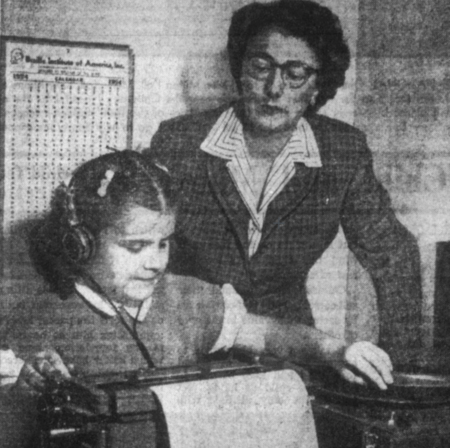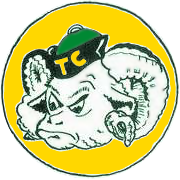People |
February 6, 2025 |
TC Schools Takes Lead Role in 1950s Special Education
Mainstream education for the blind helps set standards
February 6, 2025
The original article below precedes a personal recollection.

Marguerite McCaffrey observes as Barbara Browning masters the keyboard.
DAILY NEWS, Los Angeles Wednesday, Feb. 24. 1954
By NORMAN FRISCH Womans Page Editor
The weighty matter of whether the fourth grade class at Temple City’s Longden Avenue School should buy a turtle was voted recently by a show of hands. Deciding whether the hands of those who favored the Idea were In the majority was pretty class president, Barbara Browning, who Is totally blind. Asked how she knew most of the children, all of whom have normal vision, Incidentally, had voted yes, she replied, "If only a few had raised their hands, I couldn’t have heard them."
Barbara is a case in point at the school, which is the training center for blind and partially blind children from 23 school districts throughout the middle San Gabriel Valley.
THE POINT IS that blind children must live in a seeing world there Is no such thing as a city for the blind so the time .to start training them for that world Is when they, are young. So said Miss Clarice Manshardt, director of education In the Temple City school system and one of the founders three years ago of the (district’s) program for training partially sighted and non-slghted children.
Miss Manshardt said most cities segregate their blind pupils, as does Los Angeles at the Blind School, which Is adjacent to the 32nd St. School. She said Los Angeles has "a fine program for Its blind pupils, but she Just doesn’t happen to agree with the segregation approach. In telling why, she got back to Barbara and recalled how she announced to the class before the turtle vote, "I want to thank everybody who’s been taking my hand and leading me to the playground. But I want to ask you not to anymore. I know my way now."
IN OTHER WORDS the director said, blind children can and do adjust And the process proves as much an education for the sighted as for the blind. . She told how a normal girl, who momentarily was stumped, 'quickly devised a way to teach a blind girl how to jump rope.' First she lifted one of the blind girls feet next the other and then she put the blind girl’s hands on her shoulders while she jumped up and down. That’s all there was to it.
Not all the teaching Is done by the sighted, the director continued. On a recent trip by the first graders to a nearby sawmill," she said all that the normal children saw was a lot of saws. But a little blind fellow of Mexican descent asked the operator "What’s that loud noise and whats that quieter noise." Through his ears, she explained, they learned there weren’t just a lot of saws, but four distinctly different kinds.
The 12 partially sighted 10 totally blind youngsters at the Longden Avenue School range from first through sixth graders and all spend most of their school time in normal classes. The rest of their time Is spent, as needed in the resource room, where they learn to read and write braille, to run a typewriter and other special equipment.
GETTING THE MONEY to buy this equipment Is one of her problems, Miss Manshardt said. Another Is finding specially trained teachers. Help on the equipment matter came last week in .the. form of checks from both the Juniors and Seniors In the Temple City Womens Club. And more will come with proceeds from the Juniors rummage sale April 3.
Help on the teacher problem comes from Temple City and Its many service .organizations. They’ve set up scholarships to send selected young women to. special classes at San Francisco State College. Two already have been trained and a third, Miss Jane Lee, recently was selected to follow. That should be good news to the parents of 25 blind preschool children already known to reside In middle San Gabriel Valley.
PHILANTHROPY CHAIRMEN (above photo) Mrs. George Burza (L) of Temple Club and Mrs. F. P. Martin of the city's Senior Women's Club proudly display checks their organizations are giving for purchase of equipment to teach blind children at the Longden Avenue School. Happy about it is Miss Jane Lee, because she just won a scholarship for special instruction and probably will be teaching there soon.
In (adjacent) photo, fourth-grader Barbara Browning, who is totally blind, learns how to use a typewriter in the Temple .City school's resource room with the aid of her teacher, Marguerite McCaffrey, and recorded instructions from the record player. The typewriter gives the blind a good, legible means of communication, the teacher pointed out. :-) Transcribed 2025, ARC.
I’m happy to say I knew Clarice Manshardt, Marguerite McCaffrey and Barbara Browning. "Miss M" and Mrs. McC were frequent guests at our house in the 1940s and 50s, back in the times when children called their elders by their proper names. My mother, Gwendolyn Clark, was the school district’s supervisor of curricular materials and actually bought some of the teaching aids mentioned in the article; she was also known as the district’s sole roving art teacher..
Barbara Browning (1944-2021) was special. Sunny, bright and intellectual, she became an accomplished pianist by her teens, complete with the ability to key shift and render accompaniment for multiple voices. In 1960 I had the pleasure of performing a duet with her that she arranged, taught to me and accompanied. We sang Rodgers and Hammerstein’s "We Kiss in the Shadows" from "The King and I" before the rest of the school choir in a "command performance" — by which I mean that it was first period and the State of California commanded everyone enrolled to show up, and on time. :-) Never to be forgotten.
Temple City was a leader in special education in the 1950s, far ahead of its time. The article makes clear that community support made the whole enterprise possible. Other nearby districts gradually established parallel programs specialized for other forms of full or partial disability. I’ve always been proud to be from a place that exemplified — in contrast to certain prevailing trends of the present era — diversity, equity and inclusiveness.
Temple City School Trains the Blind to Live in a Seeing World
By NORMAN FRISCH Womans Page Editor
The weighty matter of whether the fourth grade class at Temple City’s Longden Avenue School should buy a turtle was voted recently by a show of hands. Deciding whether the hands of those who favored the Idea were In the majority was pretty class president, Barbara Browning, who Is totally blind. Asked how she knew most of the children, all of whom have normal vision, Incidentally, had voted yes, she replied, "If only a few had raised their hands, I couldn’t have heard them."
Barbara is a case in point at the school, which is the training center for blind and partially blind children from 23 school districts throughout the middle San Gabriel Valley.
THE POINT IS that blind children must live in a seeing world there Is no such thing as a city for the blind so the time .to start training them for that world Is when they, are young. So said Miss Clarice Manshardt, director of education In the Temple City school system and one of the founders three years ago of the (district’s) program for training partially sighted and non-slghted children.
Miss Manshardt said most cities segregate their blind pupils, as does Los Angeles at the Blind School, which Is adjacent to the 32nd St. School. She said Los Angeles has "a fine program for Its blind pupils, but she Just doesn’t happen to agree with the segregation approach. In telling why, she got back to Barbara and recalled how she announced to the class before the turtle vote, "I want to thank everybody who’s been taking my hand and leading me to the playground. But I want to ask you not to anymore. I know my way now."
IN OTHER WORDS the director said, blind children can and do adjust And the process proves as much an education for the sighted as for the blind. . She told how a normal girl, who momentarily was stumped, 'quickly devised a way to teach a blind girl how to jump rope.' First she lifted one of the blind girls feet next the other and then she put the blind girl’s hands on her shoulders while she jumped up and down. That’s all there was to it.
Not all the teaching Is done by the sighted, the director continued. On a recent trip by the first graders to a nearby sawmill," she said all that the normal children saw was a lot of saws. But a little blind fellow of Mexican descent asked the operator "What’s that loud noise and whats that quieter noise." Through his ears, she explained, they learned there weren’t just a lot of saws, but four distinctly different kinds.
The 12 partially sighted 10 totally blind youngsters at the Longden Avenue School range from first through sixth graders and all spend most of their school time in normal classes. The rest of their time Is spent, as needed in the resource room, where they learn to read and write braille, to run a typewriter and other special equipment.
GETTING THE MONEY to buy this equipment Is one of her problems, Miss Manshardt said. Another Is finding specially trained teachers. Help on the equipment matter came last week in .the. form of checks from both the Juniors and Seniors In the Temple City Womens Club. And more will come with proceeds from the Juniors rummage sale April 3.
Help on the teacher problem comes from Temple City and Its many service .organizations. They’ve set up scholarships to send selected young women to. special classes at San Francisco State College. Two already have been trained and a third, Miss Jane Lee, recently was selected to follow. That should be good news to the parents of 25 blind preschool children already known to reside In middle San Gabriel Valley.
PHILANTHROPY CHAIRMEN (above photo) Mrs. George Burza (L) of Temple Club and Mrs. F. P. Martin of the city's Senior Women's Club proudly display checks their organizations are giving for purchase of equipment to teach blind children at the Longden Avenue School. Happy about it is Miss Jane Lee, because she just won a scholarship for special instruction and probably will be teaching there soon.
In (adjacent) photo, fourth-grader Barbara Browning, who is totally blind, learns how to use a typewriter in the Temple .City school's resource room with the aid of her teacher, Marguerite McCaffrey, and recorded instructions from the record player. The typewriter gives the blind a good, legible means of communication, the teacher pointed out. :-) Transcribed 2025, ARC.
* * *
I’m happy to say I knew Clarice Manshardt, Marguerite McCaffrey and Barbara Browning. "Miss M" and Mrs. McC were frequent guests at our house in the 1940s and 50s, back in the times when children called their elders by their proper names. My mother, Gwendolyn Clark, was the school district’s supervisor of curricular materials and actually bought some of the teaching aids mentioned in the article; she was also known as the district’s sole roving art teacher..
Barbara Browning (1944-2021) was special. Sunny, bright and intellectual, she became an accomplished pianist by her teens, complete with the ability to key shift and render accompaniment for multiple voices. In 1960 I had the pleasure of performing a duet with her that she arranged, taught to me and accompanied. We sang Rodgers and Hammerstein’s "We Kiss in the Shadows" from "The King and I" before the rest of the school choir in a "command performance" — by which I mean that it was first period and the State of California commanded everyone enrolled to show up, and on time. :-) Never to be forgotten.
Temple City was a leader in special education in the 1950s, far ahead of its time. The article makes clear that community support made the whole enterprise possible. Other nearby districts gradually established parallel programs specialized for other forms of full or partial disability. I’ve always been proud to be from a place that exemplified — in contrast to certain prevailing trends of the present era — diversity, equity and inclusiveness.
— A. R. Clark
Members may post a comment.





